Yokogawa UT35A, UT32A Operating Manual
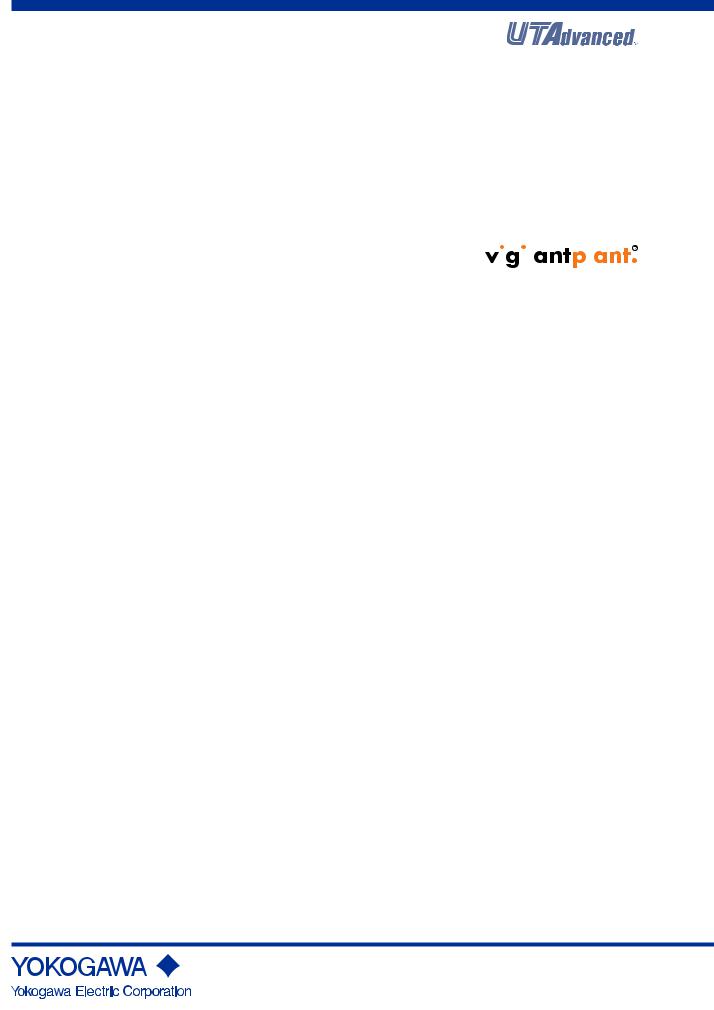
User’s |
|
|
|
|
|
|
|
|
Manual |
UT35A/UT32A |
|||||||
|
||||||||
|
Digital Indicating Controllers |
|||||||
|
User’s Manual |
|||||||
|
|
|
IM 05P01D31-01EN |
|||||
|
|
|
|
|
|
|
|
|
|
|
|
|
|
|
|
|
|
|
|
|
|
|
|
|
|
|
|
|
|
|
|
|
|
|
|
|
|
|
|
|
|
|
|
|
IM 05P01D31-01EN
1st Edition
Product Registration
Thank you for purchasing YOKOGAWA products.
YOKOGAWA provides registered users with a variety of information and services. Please allow us to serve you best by completing the product registration form accessible from our homepage.
http://www.yokogawa.com/ns/reg/

Introduction
Thank you for purchasing the UT35A/UT32A digital indicating controller (hereinafter referred to as UT35A/UT32A).
This manual describes how to use UT35A/UT32A functions other than UT35A/UT32A’s communication function and ladder sequence function. Please read through this user’s manual carefully before using the product.
Note that the manuals for the UT35A/UT32A comprise the following six documents:
● Printed manual
Manual Name |
Manual Number |
Description |
|
UT35A/UT32A |
IM 05P01D31-11EN |
This manual describes the basic operation |
|
Operation Guide |
method. |
||
|
● Electronic manuals
Manual Name |
Manual Number |
Description |
|
UT35A/UT32A |
IM 05P01D31-11EN |
This is identical to the printed manual. |
|
Operation Guide |
|||
|
|
||
UT35A/UT32A |
|
This manual. It describes the usage of all |
|
IM 05P01D31-01EN |
functions except the ladder sequence and |
||
User’s Manual |
|||
|
communication functions. |
||
|
|
||
UTAdvanced Series |
|
This manual describes how to use UT35A/ |
|
Communication Interface |
IM 05P07A01-01EN |
UT32A in Ethernet and serial communications. |
|
(RS-485, Ethernet) |
For communication wiring, see the Operation |
||
|
|||
User’s Manual |
|
Guide or User’s Manual. |
|
UTAdvanced Series |
|
This manual describes how to use UT35A/ |
|
Communication Interface |
IM 05P07A01-02EN |
UT32A in PROFIBUS-DP communications. For |
|
(PROFIBUS-DP) |
communication wiring, see the Operation Guide |
||
|
|||
User’s Manual |
|
or User’s Manual. |
|
LL50A Parameter Setting |
|
This manual describes how to install and |
|
Software Installation |
IM 05P05A01-01EN |
||
uninstall the LL50A. |
|||
Manual |
|
||
|
|
||
|
|
This manual describes how to use the LL50A, |
|
LL50A Parameter Setting |
IM 05P05A01-02EN |
ladder sequence function, peer-to-peer |
|
Software User’s Manual |
communication, and network profile creating |
||
|
|||
|
|
function. |
* User’s Manual can be downloaded from a website.
Target Readers
This guide is intended for the following personnel;
●Engineers responsible for installation, wiring, and maintenance of the equipment.
●Personnel responsible for normal daily operation of the equipment.
Notice
●The contents of this manual are subject to change without notice as a result of continuing improvements to the instrument’s performance and functions.
●Every effort has been made to ensure accuracy in the preparation of this manual.
Should any errors or omissions come to your attention, however, please inform
Yokogawa Electric’s sales office or sales representative.
●Under no circumstances may the contents of this manual, in part or in whole, be transcribed or copied without our permission.
1st Edition : Jan. 2010 (YK)
All Rights Reserved, Copyright © 2010 Yokogawa Electric Corporation
IM 05P01D31-01EN
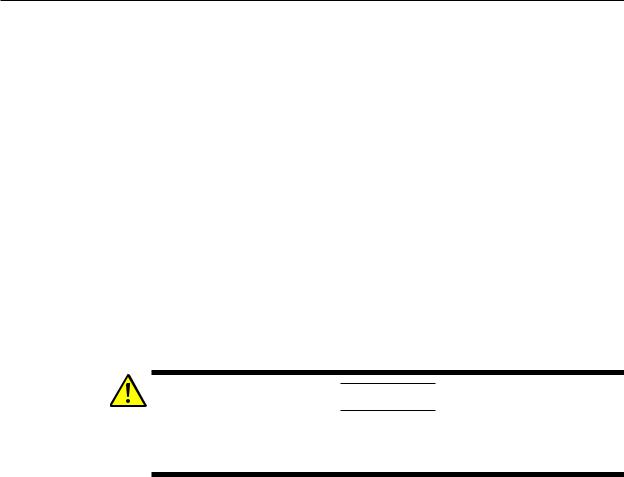
Trademarks
●Our product names or brand names mentioned in this manual are the trademarks or registered trademarks of Yokogawa Electric Corporation (hereinafter referred to as YOKOGAWA).
●Microsoft, MS-DOS, Windows, Windows XP, and Windows Vista are either registered trademarks or trademarks of Microsoft Corporation in the United States and/or other countries.
●Adobe, Acrobat, and Postscript are either registered trademarks or trademarks of
Adobe Systems Incorporated.
●Ethernet is a registered trademark of XEROX Corporation in the United States.
●Modbus is a registered trademark of Schneider Electric.
●PROFIBUS-DP is a registered trademark of PROFIBUS User Organization.
●We do not use the TM or ® mark to indicate these trademarks or registered trademarks in this user’s manual.
●All other product names mentioned in this user’s manual are trademarks or registered trademarks of their respective companies.
Safety Precautions
This instrument is a product of Installation Category II of IEC/EN/CSA/UL61010-1 Safety Standards and Class A of EN61326-1, EN55011 (EMC Standards).
CAUTION
This instrument is an EMC class A product. In a domestic environment, this product may cause radio interference in which case the user needs to take adequate measures.
The instrument is a product rated Measurement Category I (CAT.I). * Measurement Category I (CAT.I)
This category applies to electric equipment that measures a circuit connected to a low-voltage facility and receives power from stationary equipment such as electric switchboards.
To use the instrument properly and safely, observe the safety precautions described in this user’s manual when operating it. Use of the instrument in a manner not prescribed herein may compromise protection features inherent in the device. We assume no liability for or warranty on a fault caused by users’ failure to observe these instructions.
This instrument is designed to be used within the scope of Measurement Category I (CAT. I) and is dedicated for indoor use.
Notes on the User’s Manual
•This user’s manual should be readily accessible to the end users so it can be referred to easily. It should be kept in a safe place.
•Read the information contained in this manual thoroughly before operating the product.
•The purpose of this user’s manual is not to warrant that the product is well suited to any particular purpose, but rather to describe the functional details of the product.
ii |
IM 05P01D31-01EN |

Safety, Protection, and Modification of the Product
The following symbols are used in the product and user’s manuals to indicate safety precautions:
“Handle with Care” (This symbol is attached to the part(s) of the product to indicate that the user’s manual should be referred to in order to protect the operator and the instrument from harm.)
AC
AC/DC
The equipment wholly protected by double insulation or reinforced insulation.
Functional grounding terminal (Do not use this terminal as a protective grounding terminal.)
•In order to protect the system controlled by this product and the product itself, and to ensure safe operation, observe the safety precautions described in this user’s
manual. Use of the instrument in a manner not prescribed herein may compromise the product’s functions and the protection features inherent in the device. We assume no liability for safety, or responsibility for the product’s quality, performance or functionality should users fail to observe these instructions when operating the product.
•Installation of protection and/or safety circuits with respect to a lightning protector; protective equipment for the system controlled by the product and the product itself; foolproof or failsafe design of a process or line using the system controlled by the product or the product itself; and/or the design and installation of other protective and safety circuits are to be appropriately implemented as the customer deems necessary.
•Be sure to use the spare parts approved by YOKOGAWA when replacing parts or consumables.
•This product is not designed or manufactured to be used in critical applications that directly affect or threaten human lives. Such applications include nuclear power equipment, devices using radioactivity, railway facilities, aviation equipment, air navigation facilities, aviation facilities, and medical equipment. If so used, it is the user’s responsibility to include in the system additional equipment and devices that ensure personnel safety.
•Modification of the product is strictly prohibited.
WARNING
●Power Supply
Ensure that the instrument’s supply voltage matches the voltage of the power supply before turning ON the power.
●Do Not Use in an Explosive Atmosphere
Do not operate the instrument in locations with combustible or explosive gases or steam. Operation in such environments constitutes an extreme safety hazard.
Use of the instrument in environments with high concentrations of corrosive gas (H2S, SOX, etc.) for extended periods of time may cause a failure.
●Do Not Remove Internal Unit
The internal unit should not be removed by anyone other than YOKOGAWA’s service personnel. There are dangerous high voltage parts inside. Additionally, do not replace the fuse by yourself.
●Damage to the Protective Construction
Operation of the instrument in a manner not specified in this user’s manual may damage its protective construction.
IM 05P01D31-01EN |
iii |

Warning and Disclaimer
•YOKOGAWA makes no warranties regarding the product except those stated in the WARRANTY that is provided separately.
•The product is provided on an “as is” basis. YOKOGAWA assumes no liability to any person or entity for any loss or damage, direct or indirect, arising from the use of the product or from any unpredictable defect of the product.
Notes on Software
•YOKOGAWA makes no warranties, either expressed or implied, with respect to the software’s merchantability or suitability for any particular purpose, except as specified in the terms of the separately provided warranty.
•This software may be used on one specific machine only.
•To use the software on another machine, the software must be purchased again separately.
•It is strictly prohibited to reproduce the product except for backup purposes.
•Store the software CD-ROM (the original medium) in a safe place.
•All reverse-engineering operations, such as reverse compilation or the reverse assembly of the product are strictly prohibited.
•No part of the product’s software may be transferred, converted, or sublet for use by any third party, without prior written consent from YOKOGAWA.
Handling Precautions for the Main Unit
•The instrument comprises many plastic components. To clean it, wipe it with a soft, dry cloth. Do not use organic solvents such as benzene or thinner for cleaning, as discoloration or deformation may result.
•Keep electrically charged objects away from the signal terminals. Not doing so may cause the instrument to fail.
•Do not apply volatile chemicals to the display area, operation keys, etc. Do not leave the instrument in contact with rubber or PVC products for extended periods. Doing so may result in failure.
•If the equipment emits smoke or abnormal smells or makes unusual noises, turn OFF the instrument’s power immediately and unplug the device. In such an event, contact your sales representative.
Checking the Contents of the Package
Unpack the box and check the contents before using the product. If the product is different from that which you have ordered, if any parts or accessories are missing, or if the product appears to be damaged, contact your sales representative.
UT35A/UT32A Main Unit
The UT35A/UT32A main units have nameplates affixed to the side of the case.
Check the model and suffix codes inscribed on the nameplate to confirm that the product received is that which was ordered.
No. (Instrument number)
When contacting your sales representative, inform them of this number, too.
iv |
IM 05P01D31-01EN |

Model and Suffix Codes of UT35A
[Style:S1]
|
|
|
|
|
|
Optional |
|
Model |
|
Suffix code |
suffix |
Description |
|||
|
|
|
|
|
|
code |
|
UT35A |
|
|
|
|
|
|
Digital Indicating Controller (provided with retransmission output or 15 V DC |
|
|
|
|
|
|
loop power supply, 2 DIs, and 3 DOs) (Power supply: 100-240 V AC) |
|
|
|
|
|
|
|
|
|
Type 1: |
-0 |
|
|
|
|
|
Standard type |
Basic |
-1 |
|
|
|
|
|
Position proportional type |
control |
-2 |
|
|
|
|
|
Heating/cooling type |
Type 2: |
|
0 |
|
|
|
|
None |
|
1 |
|
|
|
|
2 additional DIs, 2 additional DOs |
|
Functions |
|
|
|
|
|
||
|
2 |
|
|
|
|
5 additional DIs, 5 additional DOs |
|
|
|
|
|
|
|
||
Type 3: |
|
|
0 |
|
|
|
None |
|
|
1 |
|
|
|
RS-485 communication (Max.38.4 kbps, 2-wire/4-wire) |
|
Open networks |
|
2 |
|
|
|
Ethernet communication (with serial gateway function) |
|
|
|
|
4 |
|
|
|
PROFIBUS-DP communication |
|
|
|
|
-10 |
|
|
English |
Display language (*1) |
-20 |
|
|
German |
|||
-30 |
|
|
French |
||||
|
|
|
|
|
|
||
|
|
|
|
-40 |
|
|
Spanish |
Fixed code |
|
|
|
|
-00 |
|
Always "-00" |
|
|
|
|
|
|
/LP |
24 V DC loop power supply (*2) |
Optional suffix codes |
|
|
/HA |
Heater break alarm (*3) |
|||
|
|
/DC |
Power supply 24 V AC/DC |
||||
|
|
|
|
|
|
||
|
|
|
|
|
|
/CT |
Coating (*4) |
|
|
|
|
|
*1: |
|
English, German, French, and Spanish can be displayed as the guide display. |
||
|
|
|
|
|
*2: |
|
The /LP option can be specified in the combination of Type 2 code (any of "0" or "1") and |
||
|
|
|
|
|
|
|
Type 3 code (any of "0" or "1".) |
||
|
|
|
|
|
*3: |
|
The /HA option can be specified when the Type 1 code is "-0" or "-2." |
||
|
|
|
|
|
*4: |
|
When the /CT option is specified, the UT35A does not conform to the safety standards (UL |
||
|
|
|
|
|
|
|
and CSA) and CE marking. |
||
Model and Suffix Codes of UT32A |
|||||||||
|
|
|
|
|
|
|
|
|
[Style:S1] |
|
|
|
|
|
|
|
|
Optional |
|
|
Model |
|
Suffix code |
|
suffix |
Description |
|||
|
|
|
|
|
|
|
|
code |
|
|
UT32A |
|
|
|
|
|
|
|
Digital Indicating Controller (provided with retransmission output or 15 V DC |
|
|
|
|
|
|
|
|
loop power supply, 2 DIs, and 3 DOs) (Power supply: 100-240 V AC) |
|
|
|
|
|
|
|
|
|
|
|
|
Type 1: |
-0 |
|
|
|
|
|
|
Standard type |
|
Basic |
-1 |
|
|
|
|
|
|
Position proportional type |
|
control |
-2 |
|
|
|
|
|
|
Heating/cooling type |
|
Type 2: |
|
0 |
|
|
|
|
|
None |
|
|
1 |
|
|
|
|
|
RS-485 communication (Max. 38.4 kbps, 2-wire/4-wire) |
|
|
Functions |
|
|
|
|
|
|
||
|
|
2 |
|
|
|
|
|
2 additional DIs and 2 additional DOs |
|
|
|
|
|
|
|
|
|
||
|
Type 3: |
|
|
0 |
|
|
|
|
None |
|
Open networks |
|
|
|
|
|
|||
|
|
|
|
|
|
|
|
||
|
|
|
|
|
-10 |
|
|
|
English |
|
Display language (*1) |
-20 |
|
|
|
German |
|||
|
-30 |
|
|
|
French |
||||
|
|
|
|
|
|
|
|
||
|
|
|
|
|
-40 |
|
|
|
Spanish |
|
Fixed code |
|
|
|
|
-00 |
|
|
Always "-00" |
|
|
|
|
|
|
|
|
/LP |
24 V DC loop power supply (*2) |
|
Optional suffix codes |
|
|
|
/HA |
Heater break alarm (*3) |
|||
|
|
|
|
/DC |
Power supply 24 V AC/DC |
||||
|
|
|
|
|
|
|
|
||
|
|
|
|
|
|
|
|
/CT |
Coating (*4) |
|
|
|
|
|
*1: |
|
English, German, French, and Spanish can be displayed as the guide display. |
||
|
|
|
|
|
*2: |
|
The /LP option can be specified in the combination of Type 1 code (any of "-0" or "-1") |
||
|
|
|
|
|
|
|
and Type 2 code (any of "0" or "1.") Additionally, when the Type 2 code is "1", the RS-485 |
||
|
|
|
|
|
|
|
communication is 2-wire system. |
||
|
|
|
|
|
*3: |
|
The /HA option can be specified when the Type 1 code is "-0" or "-2." |
||
|
|
|
|
|
*4: |
|
When the /CT option is specified, the UT32A does not conform to the safety standards (UL |
||
|
|
|
|
|
|
|
and CSA) and CE marking. |
||
IM 05P01D31-01EN

Coating Treatment
(1)HumiSeal coating treatment
Apply HumiSeal coating to the printed circuit board assembly.
Do not apply HumiSeal coating to the following parts: connector, gold-plated contact area, relay part, RJC device, and in the vicinity of the push switch/LED lamp.
(2)Apply terminal coating to the gold-plated contact area on the printed circuit board.
Notes
▪There are two treatments as described above, but we do not guarantee their effectiveness.
We do not supply any test data on these treatments.
▪Do not apply any treatment to the screw terminal area on the back side of the instrument.
vi |
IM 05P01D31-01EN |

Accessories
The product is provided with the following accessories according to the model and suffix codes. Check that none of them are missing or damaged.
1 |
|
|
2 |
3 |
|
|
|
4 |
|
|
|
No. |
Product Name |
Quantity |
Remark |
1 |
Brackets |
2 |
For fixing the upper and lower parts |
|
|
|
|
2 |
Unit label |
1 |
Part number: L4502VZ |
|
|
|
|
3 |
Tag label |
1 |
Part number: L4502VE |
|
|
|
|
4 |
Operation Guide |
1 |
A3 size, x 6 |
Accessory (sold separately)
The following lists an accessory sold separately.
• LL50A Parameter Setting Software
Model |
Suffix code |
Description |
|
|
|
LL50A |
-00 |
Parameter Setting Software |
|
|
|
• Terminal cover
For UT35A, Model: UTAP001 For UT32A, Model: UTAP002
For UT35A |
For UT32A |
•User’s Manual (A4 size)
*User’s Manual can be downloaded from a website.
•User’s Manual (CD-ROM), Model: UTAP003
*Contains all manuals.
IM 05P01D31-01EN |
vii |

Symbols Used in This Manual
This symbol is used on the instrument. It indicates the possibility of injury to the user or damage to the instrument, and signifies that the user must refer to the user’s manual for special instructions. The same symbol is used in the user’s manual on pages that the user needs to refer to, together with the term “WARNING” or “CAUTION.”
WARNING
Calls attention to actions or conditions that could cause serious or fatal injury to the user, and indicates precautions that should be taken to prevent such occurrences.
CAUTION
Calls attention to actions or conditions that could cause injury to the user or damage to the instrument or property and indicates precautions that should be taken to prevent such occurrences.
Note
Identifies important information required to operate the instrument.
Indicates related operations or explanations for the user’s reference.
[ ] Indicates a character string displayed on the display.
Setting Display
Indicates a setting display and describes the keystrokes required to display the relevant setting display.
Setting Details
Provides the descriptions of settings.
Description
Describes restrictions etc. regarding a relevant operation.
viii |
IM 05P01D31-01EN |
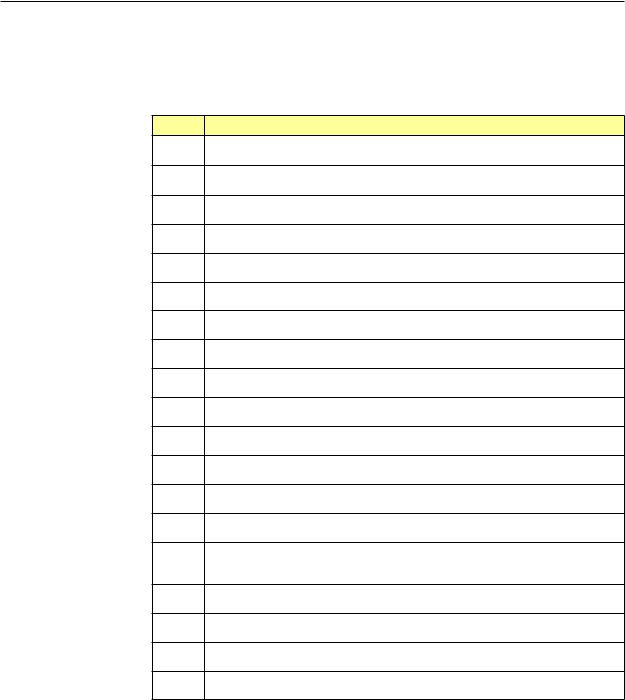
How to Use This Manual
For the ladder sequence and communication functions, see the respective manuals. This user’s manual is organized into Chapters 1 to 19 as shown below. This manual mainly uses the illustrations of the UT35A for describing the operations and functions. The basic operations are the same for the UT32A, so please read them in the same way.
Chapter |
Title and Description |
1Introduction to Functions
Describes the main functions of the UT35A/UT32A.
2UT35A/UT32A Operating Procedures
Describes the flow from unpacking to regular operations.
3Part Names
Describes part names and functions on the front panel.
4Basic Operation
Describes basic operation of the UT35A/UT32A.
5Quick Setting Function
Describes the minimum necessary settings for operation.
6Monitoring and Control of Regular Operations
Describes monitoring displays of regular operations and operation.
7Input (PV) Functions
Describes PV input.
8Control Functions
Describes basic control and advanced control.
9Auxiliary Control Functions
Describes auxiliary control functions
10Output (Control and Retransmission) Functions
Describes output functions.
11Alarm Functions
Describes alarm output and status output.
12Contact Input/Output Functions
Describes contact input/output functions.
13Display, Key, and Security Functions
Describes display, user function key and security functions.
14Parameter Initialization
Describes the initialization to factory default values and to user default values.
Power Failure Recovery Processing/Power Frequency Setting/Other Settings
15Describes operations performed after momentary power interruption and power failures.
16Troubleshooting, Maintenance, and Inspections
Describes troubleshooting, maintenance, periodic inspections, and disposal.
17Installation and Wiring
Describes installation and wiring.
18Parameters
Provides parameter maps.
19Specifications
Provides the UT35A/UT32A specifications.
IM 05P01D31-01EN |
ix |

Blank Page

Contents
|
Introduction............................................................................................................................ |
i |
|
Target Readers...................................................................................................................... |
i |
|
Notice ................................................................................................................................. |
i |
|
Trademarks........................................................................................................................... |
ii |
|
Safety Precautions................................................................................................................ |
ii |
|
Handling Precautions for the Main Unit............................................................................... |
iv |
|
Checking the Contents of the Package................................................................................ |
iv |
|
Model and Suffix Codes of UT35A........................................................................................ |
v |
|
Model and Suffix Codes of UT32A........................................................................................ |
v |
|
Symbols Used in This Manual............................................................................................ |
viii |
|
How to Use This Manual...................................................................................................... |
ix |
Chapter 1 Introduction to Functions |
|
|
1.1 |
Quick Setting Function...................................................................................................... |
1-1 |
1.2 |
Input/Output Function....................................................................................................... |
1-2 |
1.3 |
Control Functions.............................................................................................................. |
1-4 |
1.4 |
Display and Key Functions............................................................................................... |
1-6 |
1.5 |
Ladder Sequence Function............................................................................................... |
1-7 |
1.6 |
Communication Functions................................................................................................ |
1-8 |
1.7 |
Definition of Main Symbols and Terms............................................................................. |
1-11 |
Chapter 2 UT35A/UT32A Operating Procedures |
|
|
2.1 |
UT35A/UT32A Operating Procedures............................................................................... |
2-1 |
Chapter 3 Part Names |
|
|
3.1 |
Names and Functions of Display Parts............................................................................. |
3-1 |
3.2 |
Names and Functions of Keys.......................................................................................... |
3-4 |
3.3 |
List of Display Symbols..................................................................................................... |
3-7 |
3.4 |
Brief Description of Setting Details (Parameters)............................................................... |
3-9 |
Chapter 4 Basic Operation |
|
|
4.1 |
Overview of Display Switch and Operation Keys.................................................................... |
4-1 |
4.2 |
How to Set Parameters..................................................................................................... |
4-4 |
Chapter 5 Quick Setting Function |
|
|
5.1 |
Setting Using Quick Setting Function............................................................................... |
5-1 |
|
Flowchart of Quick Setting Function..................................................................................... |
5-2 |
5.2 |
Restarting Quick Setting Function.................................................................................... |
5-6 |
Chapter 6 Monitoring and Control of Regular Operations |
|
|
6.1 |
Monitoring and Control of Operation Displays.................................................................. |
6-1 |
|
6.1.1 Operation Display Transitions............................................................................. |
6-1 |
|
Standard Type...................................................................................................................... |
6-1 |
|
Position Proportional Type................................................................................................... |
6-2 |
|
Heating/cooling Type............................................................................................................ |
6-3 |
|
Two-position two-level control.............................................................................................. |
6-4 |
6.2 |
Setting Target Setpoint...................................................................................................... |
6-9 |
|
Operation in the Operation Display...................................................................................... |
6-9 |
|
Operation in Parameter Setting Display............................................................................. |
6-10 |
6.3 |
Performing and Canceling Auto-tuning............................................................................ |
6-11 |
6.4 |
Adjusting PID Manually................................................................................................... |
6-14 |
|
|
|
IM 05P01D31-01EN |
|
xi |
1
2
3
4
5
6
7
8
9
10
11
12
13
14
15
16
17
18
19
App
Index

Contents
6.5 |
Setting Alarm Setpoint.................................................................................................... |
6-20 |
6.6 |
Selecting Target Setpoint Number (SPNO)..................................................................... |
6-21 |
6.7 |
Switching Operation Modes............................................................................................ |
6-22 |
|
6.7.1 Switching between AUTO and MAN.................................................................. |
6-22 |
|
6.7.2 Switching between STOP and RUN.................................................................. |
6-24 |
|
6.7.3 Switching between REM (Remote) and LCL (Local)......................................... |
6-26 |
6.8 |
Manipulating Control Output during Manual Operation........................................................................ |
6-28 |
6.9 |
Releasing On-State (Latch) of Alarm Output.................................................................. |
6-29 |
Chapter 7 Input (PV) Functions
7.1 |
Setting Functions of PV Input........................................................................................... |
7-1 |
|
|
7.1.1 |
Setting Input Type, Unit, Range, Scale, and Decimal Point Position................... |
7-1 |
|
7.1.2 |
Setting Burnout Detection for Input..................................................................... |
7-3 |
7.1.3Setting Reference Junction Compensation (RJC) or External Reference
|
Junction Compensation (ERJC).......................................................................... |
7-4 |
7.1.4 |
Correcting Input Value......................................................................................... |
7-5 |
|
(1) Setting Bias and Filter..................................................................................................... |
7-5 |
7.1.5 |
Setting Ratio Bias................................................................................................ |
7-6 |
Chapter 8 Control Functions
8.1 |
Control Function Block Diagrams..................................................................................... |
8-1 |
|
|
8.1.1 Single-loop Control, Heating/cooling Control, Position Proportional Control, |
|
|
|
|
and Two-position Two-level Control..................................................................... |
8-1 |
|
|
n Single-loop Control Function Block Diagram.................................................................... |
8-2 |
|
|
n Heating/cooling Control Function Block Diagram............................................................. |
8-4 |
|
|
n Position Proportional Control Function Block Diagram..................................................... |
8-6 |
|
|
n Two-position Two-level Control Function Block Diagram.................................................. |
8-8 |
8.2 |
Setting Control Type (CNT)............................................................................................. |
8-10 |
|
|
8.2.1 |
PID Control......................................................................................................... |
8-11 |
|
8.2.2 ON/OFF Control (1 point of hysteresis / 2 points of hysteresis)........................ |
8-12 |
|
|
8.2.3 |
Heating/cooling Control..................................................................................... |
8-14 |
|
8.2.4 |
Two-position Two-level Control.......................................................................... |
8-20 |
|
8.2.5 PD Control (Stable Control in Which a Setpoint is not Exceeded).................... |
8-22 |
|
8.3 |
Setting PID Control Mode (ALG)..................................................................................... |
8-23 |
|
8.4 |
Switching PID.................................................................................................................. |
8-25 |
|
|
8.4.1 Switching PID According to Target Setpoint Number (SPNO)........................... |
8-25 |
|
|
8.4.2 Switching PID According to PV......................................................................... |
8-26 |
|
|
8.4.3 Switching PID According to SP.......................................................................... |
8-28 |
|
|
8.4.4 Switching PID According to Target SP............................................................... |
8-30 |
|
|
8.4.5 Switching PID According to Deviation (Reference Deviation)........................... |
8-32 |
|
|
8.4.6 Setting Hysteresis at Time of PID Switch.......................................................... |
8-33 |
|
8.5 |
Suppressing Overshoot (Super Function)....................................................................... |
8-34 |
|
8.6 |
Suppressing Hunting (Super2 Function)......................................................................... |
8-36 |
|
8.7 |
Suppressing Integral Action (Anti-reset Wind-up)................................................................... |
8-38 |
|
8.8 |
Adjusting Auto-tuning Operation .................................................................................... |
8-39 |
|
Chapter 9 Auxiliary Control Functions
9.1 |
Setting SP Limiter............................................................................................................. |
9-1 |
9.2 |
Changing SP at a Fixed Rate (SP Ramp-Rate Setting Function)..................................... |
9-2 |
9.3 |
Forcing SP to Track PV (PV Tracking).............................................................................. |
9-4 |
9.4 |
Forcing SP to Track Remote Input (SP Tracking)................................................................ |
9-5 |
9.5 |
Setting Controller Action at Power ON (Restart Mode)......................................................................... |
9-6 |
9.6 |
Setting Time between Powering on Controller and Starting Control (Restart Timer)........ |
9-7 |
|
|
|
xii |
IM 05P01D31-01EN |
|

|
|
|
Contents |
|
Chapter 10 Output (Control and Retransmission) Functions |
|
|
||
10.1 |
Setting Control Output Type............................................................................................ |
10-1 |
|
|
10.2 |
Setting Control Output Cycle Time.................................................................................. |
10-5 |
|
|
10.3 |
Setting Limiter to Control Output..................................................................................... |
10-6 |
|
|
10.4 |
Disabling Output Limiter in MAN mode........................................................................... |
10-7 |
|
|
10.5 |
Setting Velocity Limiter to Control Output....................................................................... |
10-8 |
|
|
10.6 |
Reducing 4-20 mA Current Output to 0 mA (Tight Shut Function).................................. |
10-9 |
|
|
10.7 |
Setting ON/OFF Control Hysteresis.............................................................................. |
10-10 |
|
|
10.8 |
Canceling Offset of PV and SP (Manual Reset)........................................................... |
10-12 |
|
|
10.9 |
Setting Hysteresis and Dead Band for Heating/cooling Control Output........................ |
10-13 |
|
|
10.10 |
Setting Hysteresis and Dead Band for Position Proportional Control Output............... |
10-15 |
|
|
10.11 |
Setting Retransmission Output Terminal, Type, and Scales......................................... |
10-16 |
|
|
10.12 |
Setting Preset Output Value.......................................................................................... |
10-18 |
|
|
|
10.12.1 Setting Output Value in STOP Mode (Preset Output)..................................... |
10-18 |
|
|
|
10.12.2 Setting Output Value When Switched to MAN Mode (Manual Preset Output).......... |
10-20 |
|
|
|
10.12.3 Setting Output Value When Error Occurs (Input Error Preset Output)............ |
10-21 |
|
|
10.13 |
Changing Current Output Range.................................................................................. |
10-22 |
|
|
10.14 |
Adjusting Motor-operated Valve Position (Position Proportional Output)...................... |
10-23 |
|
|
|
10.14.1 Setting Valve Operation Mode......................................................................... |
10-24 |
|
|
|
10.14.2 Adjusting Valve Position Automatically............................................................ |
10-24 |
|
|
|
10.14.3 Adjusting Valve Position Manually................................................................... |
10-25 |
|
|
|
10.14.4 Setting Valve Traveling Time (Estimating Type).............................................. |
10-26 |
|
|
|
10.14.5 Selecting Feedback Input (Resistor/Current).................................................. |
10-26 |
|
|
10.15 |
Using 15 V DC Loop Power Supply.............................................................................. |
10-27 |
|
|
Chapter 11 Alarm Functions |
|
|
||
11.1 |
Setting Alarm Type........................................................................................................... |
11-1 |
|
|
11.2 |
Setting Number of Alarm Groups to Use........................................................................ |
11-13 |
|
|
11.3 |
Setting Hysteresis to Alarm Operation........................................................................... |
11-14 |
|
|
11.4 |
Delaying Alarm Output (Alarm Delay Timer).................................................................. |
11-15 |
|
|
11.5 |
Setting Alarm Output to Control Relay Terminal............................................................. |
11-16 |
|
|
11.6 |
Setting Alarm Action According to Operation Mode....................................................... |
11-17 |
|
|
11.7 |
Setting Heater Break Alarm........................................................................................... |
11-18 |
|
|
Chapter 12 Contact Input/Output Functions |
|
|
||
12.1 |
Setting Contact Input Function........................................................................................ |
12-1 |
|
|
|
12.1.1 Setting Contact Input Function.......................................................................... |
12-1 |
|
|
|
12.1.2 Changing Contact Type of Contact Input........................................................... |
12-9 |
|
|
12.2 |
Setting Contact Output Function................................................................................... |
12-10 |
|
|
|
12.2.1 Setting Function of Contact Output................................................................. |
12-10 |
|
|
|
12.2.2 Changing Contact Type of Contact Output...................................................... |
12-14 |
|
|
Chapter 13 Display, Key, and Security Functions |
|
|
||
13.1 |
Setting Display Functions............................................................................................... |
13-1 |
|
|
|
13.1.1 Setting Active Color PV Display Function.......................................................... |
13-1 |
|
|
|
13.1.2 Masking Arbitrary Display Value in Operation Display....................................... |
13-4 |
|
|
|
13.1.3 Registering SELECT Display (Up to 5 Displays)............................................... |
13-5 |
|
|
|
13.1.4 |
Changing Event Display.................................................................................... |
13-6 |
|
|
13.1.5 Registering SELECT Parameter Display (Up to 10 Displays)........................... |
13-8 |
|
|
|
13.1.6 Setting Bar-graph Display Function................................................................. |
13-10 |
|
|
|
13.1.7 Masking Least Significant Digit of PV Display................................................. |
13-12 |
|
|
|
13.1.8 |
Setting Economy Mode................................................................................... |
13-13 |
|
|
|
|
|
|
IM 05P01D31-01EN |
|
|
xiii |
|
1
2
3
4
5
6
7
8
9
10
11
12
13
14
15
16
17
18
19 App Index

Contents
|
|
13.1.9 |
Selecting the Initial Operation Display that Appears at Power ON.................. |
13-14 |
|
|
13.1.10 |
Setting Message Function............................................................................... |
13-15 |
|
|
13.1.11 |
Switching Guide Display Language................................................................. |
13-15 |
|
|
13.1.12 |
Changing Guide Scroll Speed......................................................................... |
13-16 |
|
|
13.1.13 |
Turning Guide Display ON/OFF...................................................................... |
13-16 |
|
|
13.1.14 |
Setting Automatic Return to Operation Display............................................... |
13-16 |
|
|
13.1.15 Setting Brightness and Contrast Adjustment of LCD and Display Update Cycle.. |
13-17 |
|
|
13.2 |
Assigning Function to User Function Key and A/M Key................................................ |
13-18 |
|
|
13.3 |
Setting Security Functions............................................................................................ |
13-21 |
|
|
|
13.3.1 |
Setting a Password......................................................................................... |
13-21 |
|
|
13.3.2 |
Setting Parameter Display Level..................................................................... |
13-21 |
|
|
13.3.3 |
Locking (Hiding) Parameter Menu Display...................................................... |
13-22 |
|
|
13.3.4 |
Key Lock.......................................................................................................... |
13-23 |
|
|
13.3.5 |
Setting Display/Non-display of Operation Display........................................... |
13-23 |
|
|
13.3.6 |
Prohibiting Writing via Communication............................................................ |
13-24 |
|
13.4 |
Confirmation of Key and I/O Condition and Version..................................................... |
13-25 |
|
|
|
13.4.1 |
Confirmation of Key and I/O Condition............................................................ |
13-25 |
|
|
13.4.2 |
Confirmation of Version................................................................................... |
13-28 |
Chapter 14 |
Parameter Initialization |
|
||
|
14.1 |
Initializing Parameter Settings to Factory Default Values............................................... |
14-1 |
|
|
14.2 |
Registering and Initializing User Default Values............................................................. |
14-2 |
|
|
|
14.2.1 |
Registering as User Setting (Default) Values.................................................... |
14-2 |
|
|
14.2.2 |
Initializing to User Setting (Default) Values....................................................... |
14-2 |
Chapter 15 Power Failure Recovery Processing / Power Frequency Setting / |
|
|||
|
Other Settings |
|
||
|
15.1 |
Remedies if Power Failure Occurs during Operations.................................................... |
15-1 |
|
|
15.2 |
Power Frequency Setting................................................................................................ |
15-2 |
|
Chapter 16 Troubleshooting, Maintenance, and Inspections |
|
|||
|
16.1 |
Troubleshooting.............................................................................................................. |
16-1 |
|
|
|
16.1.1 |
Troubleshooting Flowchart................................................................................ |
16-1 |
|
|
16.1.2 |
Errors at Power On............................................................................................ |
16-2 |
|
|
16.1.3 |
Errors during Operation..................................................................................... |
16-4 |
|
16.2 |
Maintenance................................................................................................................. |
16-15 |
|
|
|
16.2.1 |
Cleaning.......................................................................................................... |
16-15 |
|
|
16.2.2 |
Packaging when Shipping the Product for Repair........................................... |
16-15 |
|
|
16.2.3 |
Replacing Parts............................................................................................... |
16-15 |
|
16.3 |
Periodic Maintenance .................................................................................................. |
16-16 |
|
|
16.4 |
Disposal........................................................................................................................ |
16-17 |
|
Chapter 17 |
Installation and Wiring |
|
||
|
17.1 |
Installation Location........................................................................................................ |
17-1 |
|
|
17.2 |
Mounting Method............................................................................................................ |
17-3 |
|
|
17.3 |
External Dimensions and Panel Cutout Dimensions.................................................................... |
17-4 |
|
|
17.4 |
Wiring.............................................................................................................................. |
|
17-5 |
|
|
17.4.1 |
Important Information on Wiring........................................................................ |
17-5 |
|
|
17.4.2 |
PV Input Wiring................................................................................................. |
17-7 |
|
|
17.4.3 |
Control Output (Relay, Current, and Voltage Pulse) Wiring............................... |
17-8 |
|
|
17.4.4 |
Valve Position Output and Feedback Input Wiring.......................................... |
17-10 |
|
|
17.4.5 |
Contact Input Wiring......................................................................................... |
17-11 |
|
|
17.4.6 |
Contact Output Wiring..................................................................................... |
17-13 |
|
|
|
|
|
xiv |
|
|
IM 05P01D31-01EN |
|

|
|
Contents |
17.4.7 |
Retransmission Output Wiring ........................................................................ |
17-14 |
17.4.8 |
15 V DC Loop Power Supply Wiring............................................................... |
17-15 |
17.4.9 |
24 V DC Loop Power Supply Wiring............................................................... |
17-15 |
17.4.10 |
Heater Break Alarm Wiring.............................................................................. |
17-16 |
17.4.11 |
RS-485 Communication Interface Wiring........................................................ |
17-17 |
17.4.12 |
Coordinated Operation Wiring......................................................................... |
17-18 |
17.4.13 |
Peer-to peer Communication Wiring............................................................... |
17-19 |
17.4.14 |
Ethernet Communication Interface Wiring....................................................... |
17-20 |
17.4.15 |
PROFIBUS-DP Communication Interface Wiring............................................ |
17-22 |
17.4.16 Power Supply Wiring....................................................................................... |
17-24 |
|
17.5 Attaching and Detaching Terminal Cover...................................................................... |
17-25 |
|
Chapter 18 Parameters
18.1 |
Parameter Map............................................................................................................... |
18-1 |
|
18.2 |
List of Parameters........................................................................................................... |
18-8 |
|
|
18.2.1 |
Operation Parameters....................................................................................... |
18-8 |
|
18.2.2 |
Setup Parameters........................................................................................... |
18-15 |
Chapter 19 Specifications
19.1 Hardware Specifications................................................................................................. |
19-1 |
|
19.1.1 |
Input Specifications........................................................................................... |
19-2 |
19.1.2 |
Analog Output Specifications............................................................................ |
19-3 |
19.1.3 |
Step Response Time Specifications.................................................................. |
19-4 |
19.1.4 |
Relay Contact Output Specifications................................................................. |
19-4 |
19.1.5 |
Position Proportional Output Specifications...................................................... |
19-4 |
19.1.6 |
Retransmission Output Specifications............................................................... |
19-4 |
19.1.7 |
15 V DC Loop Power Supply Specifications..................................................... |
19-4 |
19.1.8 |
Contact Input Specifications.............................................................................. |
19-5 |
19.1.9 |
Transistor Contact Output Specifications.......................................................... |
19-5 |
19.1.10 |
Heater Break Alarm Specifications.................................................................... |
19-5 |
19.1.11 |
24 V DC Loop Power Supply Specifications..................................................... |
19-5 |
19.1.12 |
Safety and EMC Standards............................................................................... |
19-6 |
19.1.13 |
Construction, Installation, and Wiring................................................................ |
19-6 |
19.1.14 |
Power Supply Specifications and Isolation ....................................................... |
19-7 |
19.1.15 |
Environmental Conditions................................................................................. |
19-8 |
Appendix Input and Output Table................................................................................
Appendix 1 Input and Output Table..........................................................................................App-1
Revision Information
1
2
3
4
5
6
7
8
9
10
11
12
13
14
15
16
17
18
19 App Index
IM 05P01D31-01EN |
xv |

Blank Page
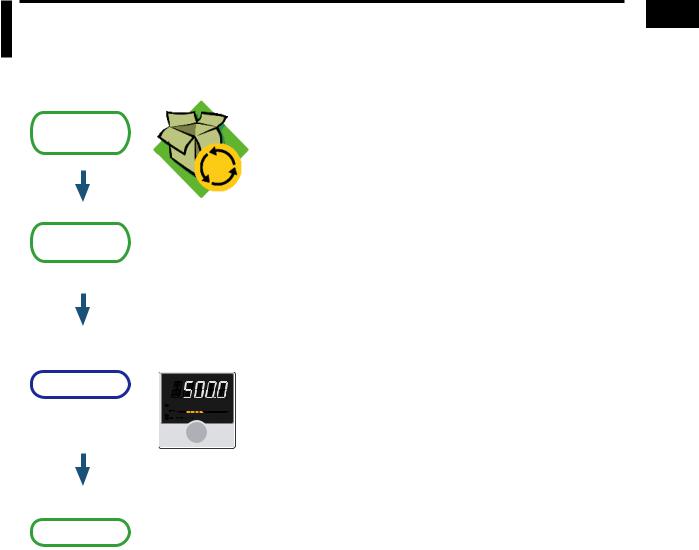
Chapter 1 Introduction to Functions
1.1Quick Setting Function
The Quick setting function is a function to easily set the basic function of the controller.
Buy and |
Check the contents. |
Unpacking |
|
Installation |
Installation and Wiring: Chapter 17 |
and Wiring |
Install and wire a controller, and then turn on the pow |
Setup |
Q: What should I do to perform control immediately? |
|
First, I want to set the input and output. |
||
|
A: Use the Quick setting function to perform the setup easily.
Quick setting function: Chapter 5
Operation |
Q: How do I determine the PID? |
|
A:Use Auto-tuning to perform the tuning easily.
Auto-tuning: Section 6.3
1
Functions to Introduction
IM 05P01D31-01EN |
1-1 |

1.2Input/Output Function
PV Input (equipped as standard)
PV input is a universal input to arbitrarily set the type and range for the thermocouple (TC), resistance-temperature detector (RTD), and DC voltage/current.
► Chapter 7 Input (PV) Functions
TC |
Current |
|
mV |
|
|
V |
|
|
mA |
|
|
|
Voltage pulse |
|
RTD |
|
|
|
Relay contact |
|
2-wire |
|
|
trans- |
Motor-operated valve |
|
mitter |
||
|
Control Output (equipped as standard)
Control output (OUT) is a universal output to arbitrarily set the type for the current, voltage pulse, and relay. Heating/cooling control and Position proportional control are possible by specifying the suffix code for the control.
Position proportional control is used exclusively for the motor-operated valve (suffix code: Type 1 = -1).
Heating/cooling control is for two output type of heat and cool (suffix code: Type 1 = -2).
► Chapter 10 Output (Control and Retransmission) Functions
TC |
Current |
|
mV |
||
|
||
V |
|
|
mA |
|
|
|
Voltage pulse |
|
RTD |
|
|
|
Relay contact |
|
2-wire |
|
|
trans- |
Motor-operated valve |
|
mitter |
Retransmission Output (equipped as standard)
Retransmission output outputs a PV input value (PV), target setpoint (SP), control output value (OUT) and the like as an analog signal to, for example, the recorder.
► Chapter 10 Output (Control and Retransmission) Functions
External device such as recorder etc.
UT35A/UT32A
Current
|
|
|
|
|
|
|
|
|
|
|
|
|
|
|
|
|
|
|
|
|
|
|
|
|
|
|
|
|
|
|
|
|
|
|
|
|
|
|
|
|
|
|
|
|
|
|
|
|
|
|
|
|
|
|
|
|
|
|
|
|
|
|
|
|
|
|
|
|
|
|
|
|
|
|
|
|
|
|
|
|
|
|
|
|
|
|
|
|
|
|
|
|
|
|
|
|
|
|
|
|
|
|
|
|
|
|
|
|
|
|
|
1-2 |
|
|
|
|
|
|
|
|
|
|
|
|
|
|
IM 05P01D31-01EN |
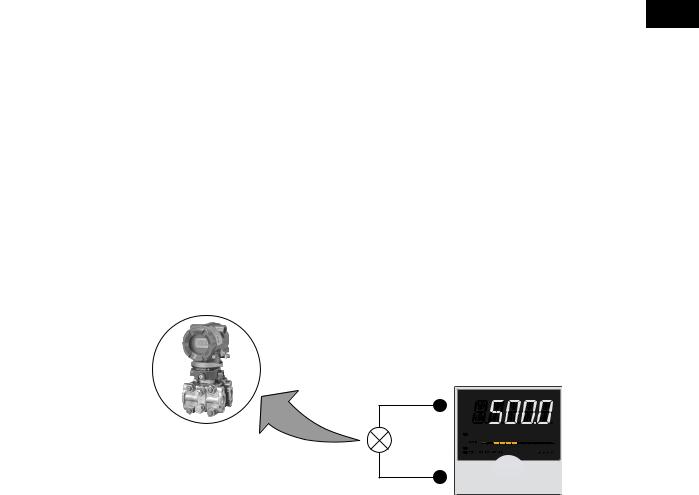
1.2 Input/Output Function
Contact Input
Up to 7 contact inputs can be incorporated. The operation modes can be switched. PID control and sequence control can be performed simultaneously using the ladder sequence function.
For details, see the table of Model and Suffix Codes.
► Chapter 12 Contact Input/Output Functions
Contact Output
Up to 8 contact outputs can be incorporated. Contact output can output events such as alarms.
PID control and sequence control can be performed simultaneously using the ladder sequence function.
For details, see the table of Model and Suffix Codes.
► Chapter 11 Alarm Functions
24 V DC Loop Power Supply (optional suffix code: /LP)
24 V DC loop power supply can be supplied to 2-wire transmitter.
► 17.4.10 24 V DC Loop Power Supply Wiring
UT35A/UT32A
2-wire transmitter
1
Functions to Introduction
|
|
|
|
|
|
IM 05P01D31-01EN |
1-3 |
|

1.3Control Functions
PID Control
PID control is a general control using the PID control-related parameters.
► 8.2.1 PID Control
Recorder |
UT35A/UT32A |
Alarms
Retransmission
output
TC
4-20 mA DC
Electric furnace
 SCR
SCR
Thyristor
Heating/cooling Control (suffix code: Type 1 = -2)
Heating/cooling control is available only for Heating/cooling type.
In Heating/cooling control, the controller outputs the result of control computation after splitting it into heating-purpose and cooling-purpose signals.
► 8.2.3 Heating/cooling Control
UT35A/UT32A |
||
Cooling (relay signal) |
|
|
Heating |
PV |
|
(4-20 mA DC signal) |
||
|
||
Heating unit |
|
|
Cooling |
|
|
water |
|
|
SCR |
|
|
Thyristor |
|
|
TC |
|
|
1-4 |
IM 05P01D31-01EN |
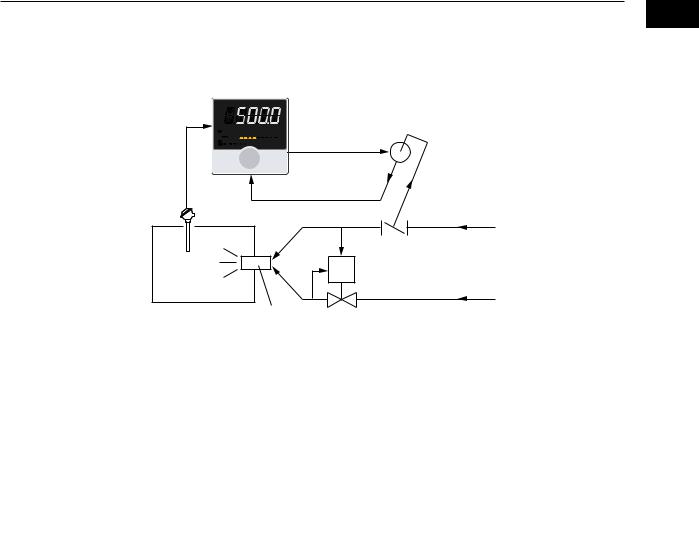
1.3 Control Functions
Position Proportional Control (suffix code: Type 1 = -1)
Position proportional control is available only for Position proportional type. It is used exclusively for the motor-operated valve.
► 10.14 Adjusting Motor-operated Valve Position (Position Proportional Output)
UT35A/UT32A
H (direct) or L (reverse)
contact signal
Control motor
Position signal
TC
|
Air |
|
Motor-operated valve |
Furnace |
Gas |
|
|
|
Burner |
Two-position Two-level Control (suffix code: Type 1 = -2)
Two-position two-level control has two target setpoints to control ON and OFF respectively.
► 8.2.4 Two-position Two-level Control
Output |
|
Hysteresis |
Hysteresis |
ON |
|
OFF |
|
|
|
|
|
PV |
Main SP |
Sub-SP |
|||
Initial value: Reverse |
Initial value: Direct |
|
||
|
|
(offset from main SP) |
|
|
1
Functions to Introduction
IM 05P01D31-01EN |
1-5 |

1.4Display and Key Functions
Employing a 14-segment, active color LCD greatly increases the monitoring and operating capabilities.
Active Color PV Display (display color change)
The active color PV display function changes the PV display color (red or white) when abnormality occurs in PV etc.
► 13.1.1 Setting Active Color PV Display Function
Normal Abnormal
Guide Display
The guide is displayed on PV display when setting parameters. This guide can be turned on/off with the Fn key.
The scrolling guide is displayed when setting parameters.
Multilingual Guide Display
English, German, French, or Spanish can be displayed in Guide display.
► 13.1.11 Switching Guide Display Language
Parameter Display Level
To intended use of the operator, the display level of the parameter can be set.
► Chapter 18 Parameters
User Function Keys
The UT35A has user function keys (F1, F2, and Fn). The UT32A has a user function key (Fn).
Assign a function to a user function key to use it as an exclusive key.
► 13.2 Assigning Function to User Function Key and A/M Key
1-6 |
IM 05P01D31-01EN |
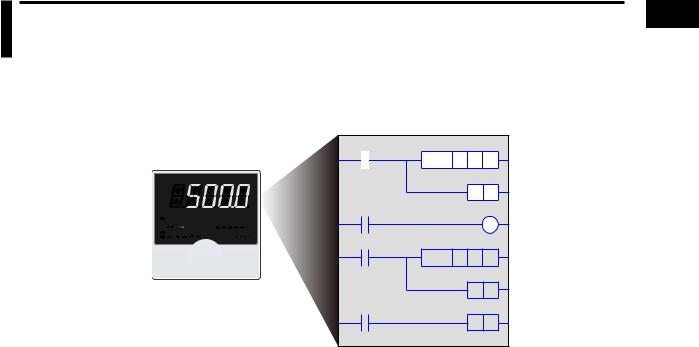
1.5Ladder Sequence Function
To use the ladder sequence function, it is necessary to create a ladder program using LL50A Parameter Setting Software and download it to a controller.
► Ladder sequence function: LL50A Parameter Setting Software User’s Manual
Ladder program
1
Functions to Introduction
|
|
|
|
|
|
|
|
|
|
|
|
|
|
|
|
|
|
|
|
|
|
|
|
|
|
|
|
|
|
|
|
|
|
|
|
|
|
|
|
|
|
|
|
|
|
|
|
|
|
|
|
|
|
|
|
|
|
|
|
|
|
|
|
|
|
|
|
|
|
|
|
|
|
|
|
|
|
|
|
|
|
|
|
|
|
|
|
|
|
IM 05P01D31-01EN |
1-7 |
||||||||

1.6Communication Functions
The UT35A/UT32A can use RS-485 communication, Ethernet communication, and PROFIBUS-DP communication by specifying the suffix code and optional suffix code for each communication.
► UTAdvanced Series Communication Interface (RS-485, Ethernet) User’s Manual
RS-485 Communication (Modbus communication, PC link communication, and Ladder communication)
The UT35A/UT32A can communicate with PCs, PLCs, touch panels, and other devices.
PC
RS-485/ |
Model: ML2 of YOKOGAWA is recommended. |
RS-232C |
|
converter |
|
Up to 31 connected slaves with a maximum length of 1200m
Ethernet Communication (Modbus/TCP)
The UT35A can be connected to IEEE802.3-compliant network (10BASE-T/100BASE-TX).
A serial gateway function can increase the number of connected controllers.
|
Host computer |
Distance from hub to controller: Within 100 m |
|
Number of cascade connections on hub: |
|
|
|
|
|
|
Max. 4 stages (10BASE-T) |
Hub |
Ethernet |
Max. 2 stages (100BASE-TX) |
LAN |
|
|
connnection |
|
|
Serial gateway function
RS-485 communication Up to 31 connected slaves with a maximum length of 1200m
|
|
|
|
|
|
|
|
|
|
|
|
|
|
|
|
|
|
|
|
|
1-8 |
|
|
|
|
|
IM 05P01D31-01EN |
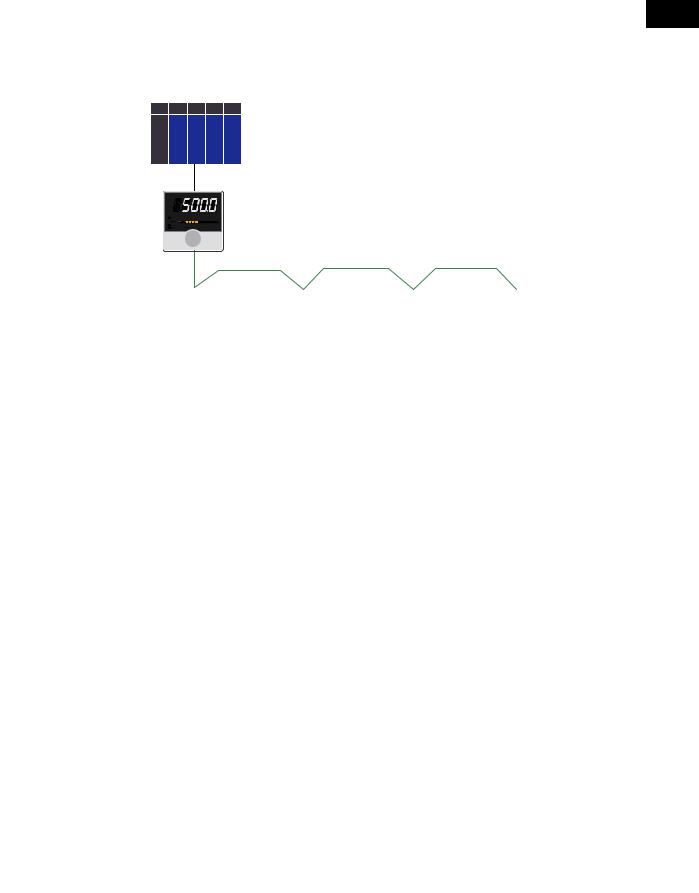
1.6 Communication Functions
PROFIBUS-DP Communication
The UT35A can be used as the slave devices for PROFIBUS-DP communication. Readout of PV, operation or alarm status, and SP setting can be done by accessing the remote I/O on the master unit of PROFIBUS-DP.
PLC
PROFIBUS-DP Master
PROFIBUS-DP communication
PROFIBUS-DP Slave / Modbus Master
Modbus/RTU communication
Max. 1200 m, number of connected slaves: 31
1
Functions to Introduction
Modbus Slave |
Modbus Slave |
Modbus Slave |
Modbus Slave |
Peer-to-peer Communication
In Peer-to-peer communication, controllers send and receive process data each other and share data. However, ladder program creation using LL50A Parameter Setting Software is necessary.
► Ladder program: LL50A Parameter Setting Software User’s Manual
Controller No. 1 to 4 can transmit and receive data. Controller No. 5 to 32 can only receive data.
|
• • |
• • |
• • • • • • |
|
1 |
2 |
4 |
15 |
32 |
Max. 32 controllers
Coordinated Operation
A system of coordinated operation is configured with a master controller and a number of slave controllers. The slave controllers are set to operate in the same way as the master controller. Therefore you do not have to create a communication program.
Master
Up to 31 connected slaves with a maximum length of 1200m
Slave |
Slave |
Slave |
Slave |
|
|
|
|
|
|
|
|
|
|
|
|
|
|
|
|
|
|
|
|
|
|
|
|
|
|
|
IM 05P01D31-01EN |
1-9 |
|||||||

1.6 Communication Functions
Light-loader Communication
Use the LL50A to set parameters and create ladder programs. Attach the adapter to the front of the controller to communicate.
► Light-loader function: LL50A Parameter Setting Software User’s Manual |
LL50A Parameter Setting Software |
Light-loader |
adapter |
To USB terminal |
Dedicated cable
Maintenance Port Communication (Power supply is not required for the UT35A/UT32A)
Maintenance port is used to connect with the dedicated cable when using LL50A Parameter Setting Software (sold separately). The parameters can be set without supplying power to the UT35A/UT32A.
LL50A Parameter Setting Software
To USB terminal 





Dedicated cable
CAUTION
When using the maintenance port, do not supply power to the controller. Otherwise, the controller does not work normally.
If power is supplied to the controller while the cable is connected, or the cable is connected to the controller already turned on, unplug the cable and turn on the controller again. The controller returns to the normal condition.
1-10 |
IM 05P01D31-01EN |

1.7Definition of Main Symbols and Terms
Main Symbol
PV: Measured input value
SP: Target setpoint
OUT: Control output value
A/M: AUTO/MAN
AUTO: Automatic
MAN: Manual
REMOTE, REM: Remote
LOCAL, LCL: Local
E1, E3, and E4: Terminal areas
► 17.4 Wiring
Engineering Units
Input range (scale): the PV range low limit is set to 0%, and the high limit is set to 100% for conversion.
Input range (scale) span: the PV range span is set to 100% for conversion.
In this manual, the parameter setting range is described as the “input range” and “input range span.” This means that engineering units are required to be set. Set a temperature for temperature input.
The following describes a conversion example.
When the PV input range is 100 to 600°C, 0% of the PV range is equivalent to 100°C, 50% of the PV range is equivalent to 350°C, and 100% of the PV range is equivalent to 600°C.
100% of the PV range span is equivalent to 500°C. 20% of the PV range span is equivalent to 100°C.
Minimum value of PV input range |
|
Maximum value of PV input range |
||
100°C |
350°C |
600°C |
||
|
|
|
|
|
1
Functions to Introduction
0% of |
PV input |
range |
50% of PV input range |
100% of |
PV input |
range |
100% of PV input range span = 500°C
The above applies to the scale for voltage and current input.
IM 05P01D31-01EN |
1-11 |
